Files in this item
Intrafamily and intragenomic conflicts in human warfare
Item metadata
| dc.contributor.author | Micheletti, Alberto J. C. | |
| dc.contributor.author | Ruxton, Graeme D. | |
| dc.contributor.author | Gardner, Andy | |
| dc.date.accessioned | 2017-02-23T10:30:10Z | |
| dc.date.available | 2017-02-23T10:30:10Z | |
| dc.date.issued | 2017-02-22 | |
| dc.identifier | 249027473 | |
| dc.identifier | b00f6555-5122-496e-8f72-a8ef24f3626c | |
| dc.identifier | 85013779304 | |
| dc.identifier | 000395893200014 | |
| dc.identifier.citation | Micheletti , A J C , Ruxton , G D & Gardner , A 2017 , ' Intrafamily and intragenomic conflicts in human warfare ' , Proceedings of the Royal Society B: Biological Sciences , vol. 284 , no. 1849 , 20162699 . https://doi.org/10.1098/rspb.2016.2699 | en |
| dc.identifier.issn | 0962-8452 | |
| dc.identifier.other | ORCID: /0000-0001-8943-6609/work/60427498 | |
| dc.identifier.uri | https://hdl.handle.net/10023/10337 | |
| dc.description | A.J.C.M. is supported by a Ph.D. studentship from the School of Biology, University of St Andrews, and A.G. is supported by a Natural Environment Research Council Independent Research Fellowship (NE/K009524/1). | en |
| dc.description.abstract | Recent years have seen an explosion of multidisciplinary interest in ancient human warfare. Theory has emphasised a key role for kin-selected cooperation, modulated by sex-specific demography, in explaining intergroup violence. However, conflicts of interest remain a relatively underexplored factor in the evolutionary-ecological study of warfare, with little consideration given to which parties influence the decision to go to war and how their motivation may differ. We develop a mathematical model to investigate the interplay between sex-specific demography and human warfare, showing that: the ecology of warfare drives the evolution of sex-biased dispersal; sex-biased dispersal modulates intrafamily and intragenomic conflicts in relation to warfare; intragenomic conflict drives parent-of-origin-specific patterns of gene expression – i.e. 'genomic imprinting' – in relation to warfare phenotypes; and an ecological perspective of conflicts at the levels of the gene, individual and social group yields novel predictions as to pathologies associated with mutations and epimutations at loci underpinning human violence. | |
| dc.format.extent | 10 | |
| dc.format.extent | 654855 | |
| dc.language.iso | eng | |
| dc.relation.ispartof | Proceedings of the Royal Society B: Biological Sciences | en |
| dc.subject | War | en |
| dc.subject | Sex-biased dispersal | en |
| dc.subject | Parent-offspring conflict | en |
| dc.subject | Sexual conflict | en |
| dc.subject | Intragenomic conflict | en |
| dc.subject | Genomic imprinting | en |
| dc.subject | GF Human ecology. Anthropogeography | en |
| dc.subject | QA Mathematics | en |
| dc.subject | QH301 Biology | en |
| dc.subject | DAS | en |
| dc.subject | BDC | en |
| dc.subject | R2C | en |
| dc.subject | SDG 16 - Peace, Justice and Strong Institutions | en |
| dc.subject.lcc | GF | en |
| dc.subject.lcc | QA | en |
| dc.subject.lcc | QH301 | en |
| dc.title | Intrafamily and intragenomic conflicts in human warfare | en |
| dc.type | Journal article | en |
| dc.contributor.sponsor | NERC | en |
| dc.contributor.institution | University of St Andrews. School of Biology | en |
| dc.contributor.institution | University of St Andrews. Centre for Biological Diversity | en |
| dc.identifier.doi | https://doi.org/10.1098/rspb.2016.2699 | |
| dc.description.status | Peer reviewed | en |
| dc.identifier.grantnumber | NE/K009524/1 | en |
This item appears in the following Collection(s)
Items in the St Andrews Research Repository are protected by copyright, with all rights reserved, unless otherwise indicated.

